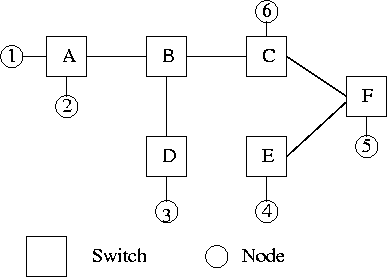- Give an example of an application where circuit-switching would be appropriate and one where packet-switching is appropriate.
- Given the following diagram of a virtual-switched network,

Show the virtual circuit tables as they develop for the following connections assuming that the virtual circuit identifier is always chosen as the lowest unused value.
Host 1 connects to host 3 Host 1 connect to host 6 Host 5 connects to host 6 Host 4 connects to host 3 Host 4 connects to host 2 Host 3 connects to host 5 - For the same network, show a routing table for router C.
- What is the maximum utilization for an ATM channel?
- The IP datagram for a TCP ACK message is 40 bytes long: it contains 20 bytes of TCP header and 20 bytes of IP header. Assume this ACK is traversing an ATM network that uses AAL5 to encapsulate the IP packets. How many ATM packets are required to carry the ACK? How many if AAL3/4 is used?
- Why are the ATM adaption layers provided?